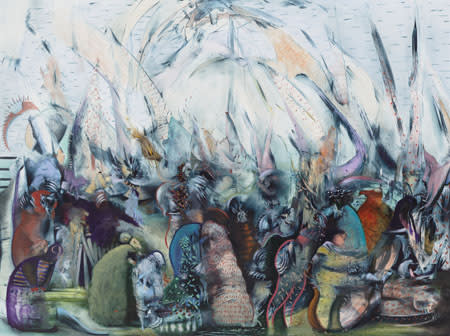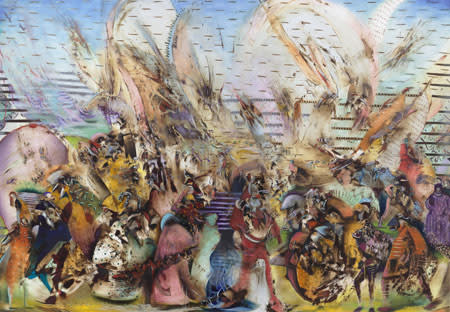
Ali Banisadr

At Galerie Thaddaeus Ropac, Paris, Ali Banisadr's brash colours and swooping gestures flirt with gaudiness
A riot of strafing lines and clashing colours, Ali Banisadr’s large painting Foreign Lands (all works 2015) seems to rush towards you like a backdraft through a broken window. You find your eyes widening to accommodate it; although it’s the furthest painting from the door as you enter the gallery, I’d be amazed if anyone glanced at any other work before it.
There is an aqueous, hallucinatory quality to many of Banisadr’s paintings, such as Age and Carousel. From a distance, they seem to have an almost digital sheen, a shimmering limpid smoothness. But this gives way, as you get up close, to intense thickets of impasto. Many of the forms poking through the foreground – particularly in Age, but also its neighbours including Metamorphosis or In Medias Res – momentarily evoke, say, the hunched monsters in a Jim Henson film, before evanescing back into smears of colour. Neither entirely abstract nor figurative, these could be Schrödinger’s paintings, hovering – like something vaguely recalled from last night’s dream – in a state of quantum uncertainty between pure expression and recognizable form. If the brash colours and swooping gestures Banisadr employs sometimes flirt with the kind of gaudiness associated with bad folk art, they’re redeemed by a hypnagogic quality that is peculiarly compelling.
Besides the nine large canvases, the exhibition is completed by a set of 13 small works on paper. They are interesting insofar as they clarify the artist’s method, the way alternations of patterned lines and dots might be broken up by a swooping gesture to give a vertiginous sense of not-quite stable three-dimensionality. But rendered in the hazy greys of charcoal these works lack the visceral thrill that comes from Banisadr’s often-lurid use of colour; restraint and reduction diminishes their power.
Speaking to Emily McDermott in Interview magazine last year, Banisadr – who now lives in the US – spoke of the synaesthesia he first became aware of during his Iranian childhood. ‘My mom says that when the Eight Years’ War was happening I would draw to create a visual understanding of the sounds I was hearing – the vibrations, explosions, and air raids,’ he said, going on to explain that sound continues to dictate his brushstrokes. ‘It’s this sound,’ he said ‘that guides me to press harder on the brush and lift off, or let go or stop there and then continue there.’
Looking at his paintings, I’m not surprised. It’s become common to compare Banisadr’s work to the paintings of Wassily Kandinsky or Hieronymous Bosch, and that makes sense enough. He shares the former’s violent, emphatic brushstroke, and with the latter a certain grotesquery coupled with a sense of peeking into a whole world unfolding before you. But far more than that, these works brought to my mind the dashing rhythms and bold symphonic timbres of Sergei Prokofiev or Igor Stravinsky.

Ali Banisadr, Age, 2015, oil on linen, 1.7 × 2.2m

Ali Banisadr, Foreign Lands, 2015, oil on linen, 2.4 × 3.5m